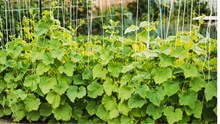
Aquaponics is the cultivation of plants and aquatic animals in a re-circulating environment, according to a report from the Food and Agriculture Organization (FAO). Aquaponics is a plant-fish collaboration, and the term is derived from the words aquaculture (the cultivation of fish in a closed environment) and hydroponics (the growing of plants usually in a soil-less environment)
Aquaponic systems are available in a variety of sizes, ranging from small indoor units to large commercial units. They can be freshwater systems or systems that contain salt or brackish water.
It is powered by a microbial ecosystem that aids in the conversion of fish effluents into usable plant nutrients while also assisting in the delivery of plant nutrients across root cell walls. Water is constantly circulated in an aquaponic system. The fish waste water is used as a nutrient in the horticultural part of the system, where plants absorb the nutrients provided by the fish waste and cleanse the water before returning it to the fish. Aquaponics is a closed-loop, resource-efficient food production system that mimics nature.
This relates to cradle-to-cradle design, which emphasises eco-effectiveness by going beyond zero emissions and producing services and products that consider social, economic, and environmental benefits.
Aquaponics In Terms of Aquaculture
As the demand for seafood has grown, technology has enabled food to be grown in both coastal marine waters and the open ocean. Aquaculture is a method of producing food and other commercial products, restoring habitat and replenishing wild stocks, and rebuilding threatened and endangered species populations.
Aquaculture is classified into two types: marine and freshwater. Furthermore, aquaculture is defined by the FAO as the captive rearing and production of fish and other aquatic animal and plant species under controlled conditions. Many aquatic species, particularly fish, crustaceans and mollusks, as well as aquatic plants and algae, have been cultured. Aquaculture production methods have evolved in various parts of the world, and have thus been adapted to the unique environmental and climatic conditions of each region. Open water systems (e.g., cages, longlines), pond culture, flow-through raceways, and recirculating aquaculture systems (RAS) are the four major types of aquaculture.
Aquaponics In Terms of Hydroponics
Other than directly from the soil, there are other ways to grow food. Soil-less cultures are used in hydroponics to grow agricultural crops without the use of soil. Various inert growing media, also known as substrates, are used in place of soil. Plant support and moisture retention are provided by these media. Irrigation systems are integrated within these media, introducing a nutrient solution to the root zones of the plants.
This solution contains all of the necessary nutrients for plant growth. Hydroponics, which involves growing plants on a substrate or in an aqueous medium with bare roots, is the most common method of soil-less culture.
How does an Aquaponics system work?
Aquaponics is a production system that combines aquaculture and hydroponics. Aquaponics is based on the introduction of food for fish, which serves as the system's input. When fish consume and process this food, they produce urine and faeces, both of which are high in ammonia and can be toxic to plants and fish in large quantities.
Following that, the water (now ammonia-rich) flows from the fish tank into a biofilter, along with uneaten food and decaying plant matter. Bacteria then break everything down inside the biofilter into organic nutrient solutions (nitrogen-rich) for growing vegetables.
As we can see, freshwater aquaponics systems rely on three main components: freshwater aquatic animals (the fish), nitrifying bacteria, and plants – and all three living entities rely on one another to survive. Plants would not have a usable form of nutrients if bacteria did not consume fish waste, which is why biological filtration is critical. Plant growth also removes nutrients from the water, leaving it clean for the fish.
Advantages of Aquaponics
-
One of the advantages of aquaponics is that it allows for an intensive food production system that is also sustainable.
-
Aquaponics is a water-efficient system that produces two agricultural products (fish and vegetables) from a single nitrogen source (fish food). In fact, aquaponics requires only 1/6th the water of traditional agriculture while producing 8 times more food per acre.
-
As aquaponics does not require soil, it is immune to soil-borne diseases.
-
Aquaponics does not necessitate the use of fertilisers or chemical pesticides.
-
Aquaponics is synonymous with higher yields and higher quality production.
-
Aquaponics imply a higher level of biosecurity and a lower risk of contamination from outside sources.
-
Aquaponics allows for greater control (because it is easier to control than soil control) overproduction, resulting in lower losses.
-
Aquaponics can be used on non-arable lands like deserts, degraded soil, or salty, sandy islands.
-
Aquaponics produces very little waste because it mimics nature's circular approach.
-
Aquaponics necessitates daily tasks such as harvesting and planting, which are labor-savingand thus suitable for people of all genders and ages.
-
Aquaponics can be used to integrate livelihood strategies for landless and poor households in order to secure food and small incomes.
-
Aquaponics produces fish protein, which is a valuable addition to many people's diets.
-
Aquaponics provides food in the form of both protein (from the fish) and vegetables from a nutritional standpoint.
















